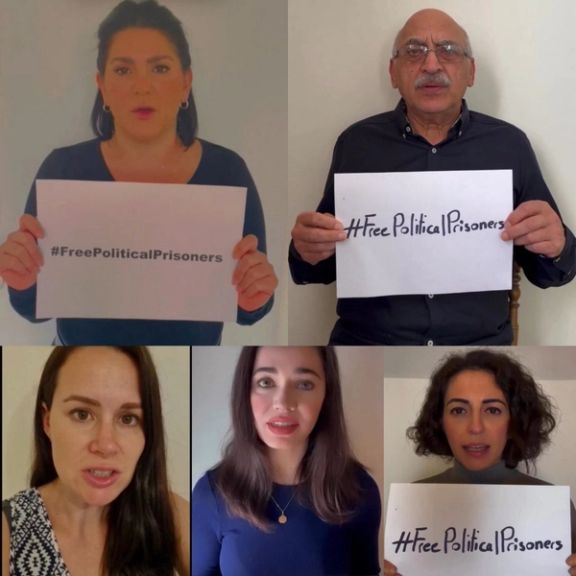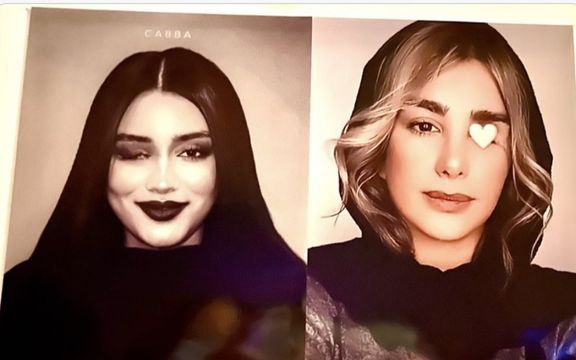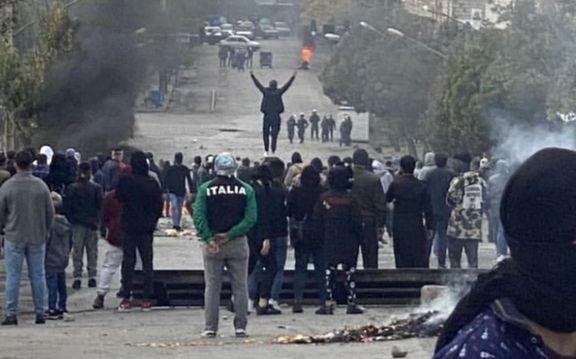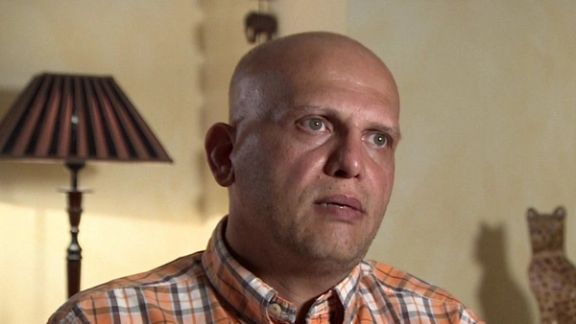Ex-Hostages Call On World To Stand Up Against Islamic Republic

Several former foreigners and dual citizens held hostage in Iran as well as their families have launched an online campaign to demand release of Iranian political prisoners.

Several former foreigners and dual citizens held hostage in Iran as well as their families have launched an online campaign to demand release of Iranian political prisoners.
Several former foreigners and dual citizens held hostage in Iran as well as their families have launched an online campaign to demand release of Iranian political prisoners.
British-Iranian businessman Anoosheh Ashoori and his daughter Elika, Kylie Moore-Gilbert, an Australian academic previously jailed in Iran for over two years, Ghazal Sharmand, the daughter of German-Iranian journalist and software engineer Jamshid Sharmahd – facing execution in Iran, and the daughter of Nahid Taghavi, another German-Iranian rights activist sentenced to 10 years in Iran since October 2020 are among the most prominent figures in the campaign.
Sharmand’s daughter said the campaign is aimed at showing the world “that the Islamic Regime’s terror extends outside of Iran’s borders, and no one is safe until we all stand up.”
Ashoori’s daughter said in a tweet that “The Islamic Republic continues its cruel practice of hostage taking, rape, torture and murder to rule by fear.”
“We’re merely a handful of families affected by this barbarity. We come together to raise awareness on the issue and appeal to the public to stand up against this regime,” she added.
Earlier in the week, Siamak Namazi, who has been kept in jail since October 2015 on trumped-up espionage charges, finished a one-week hunger strike. He released a statement saying that the seven-day hunger strike has left his body a bit weaker, but also, thanks to strong support, his spirit is greatly invigorated.

Several young Iranians who lost one or both eyes after security forces fired pellets at their faces, say they do not regret having protested against the regime.
“I don’t feel miserable because of what happened. I lost some things but gained many others,” Kowsar (Mahbanou) Khoshnoudi-Kia, a young athlete who was shot in the left eye during an anti-government protest in Kermanshah in western Iran on December 9 said in a video post.
Khoshoudi-Kia, a member of the Iranian women’s archery national team and the runner-up of the Asian Archery Championships in 2021, said despite several operations in the past two months doctors have not been able to restore her eyesight.
The incident happened while Khoshnoudi-Nia and her father participated in a “silent march”. “The anti-riot police shot at us, and we were both wounded. Two pellets hit my father’s left arm. I was hit with three in the left arm and one in the left eye,” she said in the video.
Security forces in Iran use a shotgun shell known as ‘bird shot’ with small metal pellets that is less likely to kill from a distance but can indiscriminately blind people in a crowd. Some protesters who were shot at close range died from the birdshots.
Farideh Salavatipour, another victim who was shot in Sanandaj in west Iran on November 17 has lost both eyes and there is no hope to restore her eyesight. A photo of her showing her injuries with blood trickling down from one of her eyes down her face dotted with at least eighteen birdshots was published on social media because she said she did not want to remain anonymous and be forgotten.
On December 14, the head of the accident and emergency ward of Sina Hospital in Tehran, Hossein Kermanpour, told Ham Mihan newspaper that eye injuries were at the top of all injuries sustained by protesters who were shot with pellets and birdshots.
Kermanpour added that security forces who are not properly trained cause the high number of serious injuries because they shot the victims from close distances. He also pointed out that in some instances the shooting caused injuries in the lungs and in the genital area.

Some of the victims have, however, claimed that they were purposely shot in the face or in the genital area. “Why did you shoot me? Why were you smiling when you did?” Ghazal Ranjkesh who has lost one of her eyes asked her assailant in an Instagram post. A photo she has shared of her face shows injuries from tens of birdshots. Ranjkesh was shot during a protest in Bandar Abbas in southern Iran.
According to Kermanpour, some of the victims fearing arrest if they’d sought treatment in hospitals, sometimes only did so several days after the injury and when infection had set in.
The number of protesters who were wounded in the eye during the recent protests is not known but is estimated to amount to hundreds of cases.
A group of ophthalmology professors and doctors in November warned about the high number of eye injuries caused by pellets, birdshots and paintball guns during the protests that started four months ago, and said in many cases the injuries had led to the loss of one or both eyes.
During protests in November 2021 in Esfahan in central Iran tens of protesters were also shot in the eyes. A medical official told Iranian state television at the time that 40 people had been treated for eye injuries sustained during the protests, with 19 hospitalized. An injured eye became a social-media symbol for the suppression of the protests, with many activists posting images of bloody eyes or people holding bandage to an eye

Official data show a surge of about 5,000 deaths in the Iranian month of Aban, which corresponds with days the regime intensified its crackdown on nationwide protests.
Iranian Journalist Amir-Hadi Anvari cited the data released by Iran’s National Organization for Civil Registration that shows the number of deaths registered in the country from October 23 to November 21 was around 5,000 more than in the previous month.
This can be an indication that security forces killed many more people than what human rights groups estimated, that total 500 civilian casualties in four months. Moreover the October-November period was when the regime used more deadly violence against protesters, compared with the previous month of Mehr and the following month of Azar.
According to official numbers in the civil registry, the total number of deaths recorded in the month of Aban that ended at the peak of the ongoing protests in the country was 37,488, while this number was 32,455 in the previous Iranian month and 35,564 in the month before.
In 2021, the month of Aban had fewer deaths than the preceding 30-day period, which makes the jump in 2022 more strange.
The number of deaths categorized by provinces indicates that the two provinces of Sistan-Baluchistan and Kordestan had the highest increase in the number of deaths in the mentioned timespan. The regime has confirmed that the Revolutionary Guard’s Ground Forces have been deployed to Kurdish areas to crack down on protesters, and numbers published by human rights organization also show that the highest number of protesters killed were in these two regions.
The crackdown in the Sunni majority province of Sistan-Baluchestan was especially harsh during the month of Aban. The crackdown on protesters in Zahedan, the provincial capital of Sistan-Baluchestan, known as Bloody Friday, occurred September 30, when security forces killed more than 80 people, including women and children. Sistan-Baluchestan is the country’s second largest but least developed province, and the Baluch Sunni minority is among the most persecuted in Iran.
The current wave of antigovernment protests started across the country in mid-September, following the death in custody of 22-year-old Mahsa Amini, and the regime’s crackdown got deadlier as the rallies continued.
The US-based Human Rights Activists News Agency (HRANA), one of the groups that monitors and publishes daily statistics about the protests, said Tuesday that 525 protesters have been killed from September 17 to January 23, including 71 children. The number of the arrested protesters is nearly 20,000 while the regime has so far executed four people and dozens are sentenced to ‘moharebeh’ -- meaning “fighting God” in the lexicon of the Iranian regime -- and ‘corruption on earth’ that carry the death penalty. The Islamic Republic applies the charge based on vague Islamic-Arabic terms to people who might get into a confrontation with security forces during protests.
Many people have speculated that the number of the deaths in the crackdown is way higher, but the families of the victims are threatened not to talk to the media and bury their loved ones without large funeral services or mourning ceremonies.
Although there is no possibility at this point to scientifically study the trend in the number of deaths and address all possible explanations, the 5,000 jump in one month is a cause of concern that needs further in-depth analysis.

In November 2019, a series of protests in Iran, sometimes known as Bloody November, took place throughout the country. Initially triggered by a 50 to 200-percent increase in fuel prices, the demonstrations quickly turned into calls for the overthrow of the government and Supreme Leader Ali Khamenei. According to a report by a rights group, at least 3,000 protesters were killed by the Islamic Republic security forces from November 15 to 17, and nearly 20,000 arrested. Reuters at the time reported 1,500 deaths, while the official figure announced by the regime is about 300.
In March 2022, the annual number of deaths in Iran since Covid-19 began was also reported to be 300,000 higher than previous years. The official figure that the Islamic Republic has reported is 145,000 deaths from Covid since the beginning of the pandemic, the Middle East’s highest official level - leaving 160,000 more deaths unexplained.
The data from Iran’s national organization for civil registration had put the average number of deaths at 370,000 per year for four years up to March 20, 2020, when the pandemic began. In the first year (ending March 20, 2021) deaths rose to 510,000 and in the second year to 530,000.

Despite the efforts of Iran’s sport ministry to downplay the sexual abuse of 15 teenage football students, a copy of the complaint letter of the parents shows the ministry was aware of the incident for 3 weeks.
The letter published on social media indicates that the parents of the abused kids had informed the ministry about the tragic event before the issue became public.
A former media manager for the Shahr Khodro football team in the northeastern city of Mashhad said on social media that the parents of 15 kids practicing with the club have filed a complaint against the club and coaches for sexual assault on their children, reported IRNA Friday.
Shahrara daily, which is affiliated to Mashhad municipality, reported Friday that “families of the children had gathered in front of the headquarters of the provincial football organization to protest this tragedy.”
Minister of Sports, Hamid Sajjadi claimed Monday that the ministry will continue its follow-ups to find out what had originally happened.
“There was no complaint about the issue. Only two or three objections were received by the Ministry of Sports. We intend to make a conclusion and final decision after the necessary probes,” he added.
It is not clear why the parents have not gone to the police against the unnamed coach accused of the abuse.
On the other hand, the director of the football school said, "We have not received any complaints so far, and such an issue is a plot by some people in the United States who intend to sidetrack the football and the country of Iran."

An Iranian football player has been banned from playing for his team after he refused to celebrate a winning match, saying the people of Iran are in mourning.
Reza Shekari, 24, a member of Gol Gohar club, who scored one of the goals against another team on Saturday, told reporters that he did not express happiness after scoring the goal because of the situation in the country and in respect to people who mourn those killed during antigovernment protests.
He was summoned for his comments by the disciplinary committee of the Iranian Football Federation to be suspended.
He also emphasized that he and his teammates are "forced to play football" these days.
Within the past few days, some reports said Iran’s football federation has put pressure on players to celebrate after scoring goals as is the routine in soccer. However, the federation denied the reports.
Earlier documents received by Iran International revealed that the ministry of sports in a letter had asked sports federations to prevent the symbolic gestures by athletes who support the protests.
In the past 4 months, Iranian athletes at different levels have joined the nationwide protests following the death of Mahsa Amini in police custody.
Athletes by refusing to show happiness after scoring goals, not singing the anthem of the Islamic Republic, and other symbolic gestures have shown solidarity with protesters.
The European Union on Monday sanctioned Iran’s Sports Minister Hamid Sajjadi for suppressing athletes. In its statement the EU said Sajjadi has prevented Iranian athletes from speaking against the suppression of protests.

An activist group says sixteen young people arrested in Urumieh in November, including several minors, have been tortured and threatened with rape to incriminate each other.
Follow Up Iran (komite-ye Peygiri-ye Bazdashtshodegan) which on its twitter account introduces itself as a group of activists said in a brief report on its Telegram page Sunday that the IRGC’s intelligence organization in West Azarbaijan Province has been torturing these young people to ‘confess’ against each other and say their group was in contact with foreign intelligence services.
State media reported in November that intelligence bodies had arrested 25 members of Youth of Urumieh Neighborhoods and accused them of trying “to deceive young people and incite them [to riot]”. The reports came along with group photos of two groups of blindfolded men and women holding signs with “Urumieh Neighborhoods’ Youth Organization” printed on them.
A report by the official news agency IRNA on November 17 quoted “an informed source” as saying that the “principal members of the organization were in contact with [foreign] spying agencies” and attributed the arrests to the Revolutionary Guards (IRGC) intelligence organization of West Azarbaijan.
“They have been forced into incriminating each other during interrogations and as a result of duress including beatings and threats of rape,” Follow Up Iran claimed. The activist group has also said those arrested did not know one another before getting arrested, despite IRGC’s claim that they belonged to Javan-e Mahallat-e Urumieh.
Follow Up Iran activists says in their report that sixteen, including eight young men and eight young women, are currently being prosecuted in the case. The report names eight of the detainees, including two teenagers, and says they were released on bail and are awaiting trial by the Revolutionary Court of Urumieh. The youngest among them is a fifteen-year-old girl, the report says.
The group called Javan-e Mahallat-e Urumieh is still active on social media and has never reported the arrest of any of its members. The group last tweeted on January 19.
Anonymous youth groups often calling themselves “neighborhood youth” of various Iranian cities and town, sometimes more than one in each place, emerged on social media in mid-October.
The groups sprang up after Tehran Youth (Javanan-e Tehran) managed to mobilize several successful “neighborhood-centered” protests and thousands of protesters in several towns and cities at a time of serious internet disruptions only through their activity on Twitter, Instagram and Telegram.
Some of the neighborhood groups have since then formed larger coalition groups, namely the Voice of People Coalition (Etelaf-e Seda-ye Mardom) which supports the leadership of Iran's exiled Prince Reza Pahlavi and the United Youth of Iran (Etehad-e Javanan-e Mahallat-e Iran) which said it was a coalition of thirty different youth groups and published a manifesto in December. The Urumieh youth group does not appear to be in either coalition.
Torturing detainees to incriminate themselves and others according to a scenario fabricated by intelligence bodies has several precedents. The so-called “confessions” of the accused is usually used for propaganda and are aired by the state television.
In 2019, Mazyar Ebrahimi, a businessman, disclosed how he was tortured non-stop for forty days by the intelligence ministry into confessing to spying for Israel and assassinating Iranian nuclear scientists between 2010 and 2012.

Ebrahimi’s confessions were broadcast by the state broadcaster (IRIB). He also said the judge who tried him and others on these bogus charges, Abolghasem Salavati, constantly threatened them with a death sentence to make them accept “to cooperate” with their interrogators.
In a rare incident, Ebrahimi and others were exonerated when the rival IRGC intelligence found discrepancies in the testimonies fabricated by the intelligence ministry.
Tweet unavailable